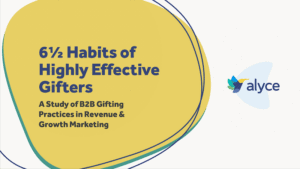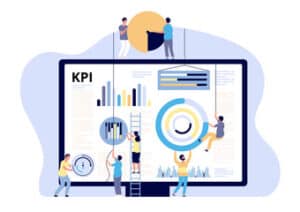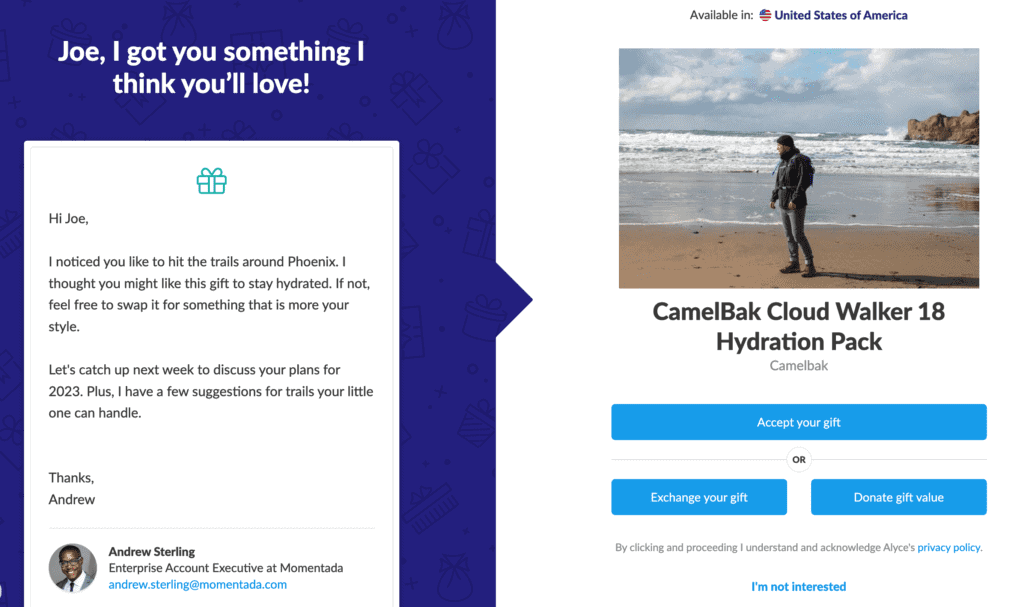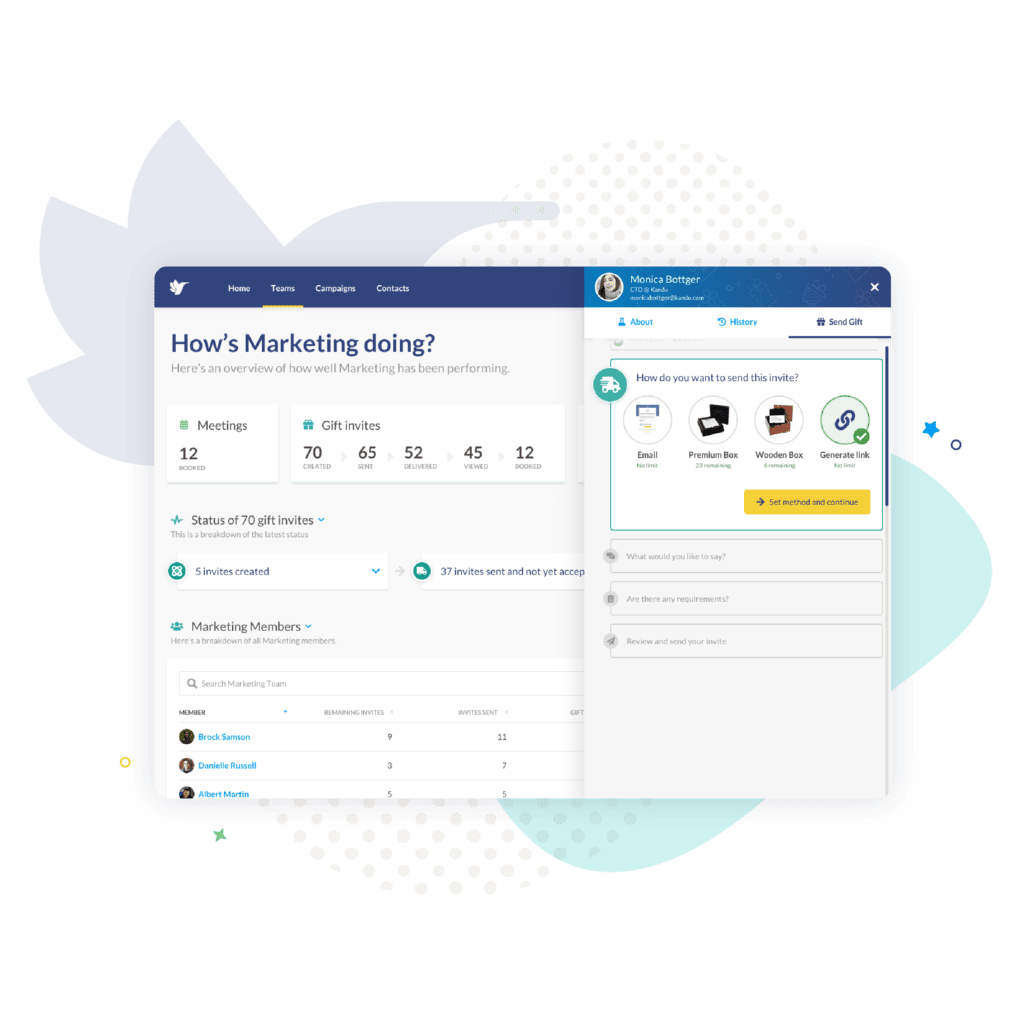
In a world where we’re constantly bombarded with information and marketing messages, we know it’s noisy out there. With no shortage of boring, one-size-fits-all emails, salesy IMs, and cold pitches bound for junk folders, it’s making it challenging for marketers to cut through the noise to reach their intended prospects and customers.
Much less, it’s even harder for them and their BDR, sales rep, and CSM counterparts to create meaningful conversations that are essential to ultimately win their business.
Just Like Every Month-end, Revenue Targets Are Certain
Despite the challenging landscape, we know you’re still on the hook to deliver. Given revenue targets remain the same, this means you have to find new ways to reach, engage and win over your audience.
Once you do, the work isn’t done. From there, as a marketer, sales rep, or CSM, you have to stay top of mind and continue to cut through the noise to build relationships with other influencers in the organization.
You also have to distance yourself from your competitors and continue to add value to build confidence that when they’re ready to buy, you’ve established an airtight case that solidifies, hands down, you are the partner of choice.
Building confidence early in the stage of the sales relationship helps them realize they’ll see a more rapid time to value, promises will become their reality, and, ideally that they can’t believe they didn’t partner with you sooner.
Let’s explore some options on how to cut through the noise to reach prospects and customers.
It’s Time to Think Differently About Marketing
Rather than continuing with the same status quo tactics, it’s time to improve how we go to market. Marketing should be thought of as not a channel, sales process or department but a mindset and a set of activities that help businesses create conversations by adding value for their prospects and customers.
It’s an opportunity to invest in each person and connect with them as real people with unique interests, needs, and priorities—unlike batch-and-blast methods that require nothing. This opens the door to engage through continued conversations, alleviate concerns in the sales cycle that naturally arise when faced with the possibility of change, and accelerate sales pipeline and buying decisions to earn their business.
And from there, it’s continuing to add value over the entire sales process, buyer journey, and customer lifecycle.
But given time is always of the essence, and big go-to-market and product strategy shifts can add risk, we think the best approach is making incremental adjustments to the buyer experience and sales process, building upon what you already have.
Fortunately, to cut through the noise, there are steps you can take to create a plan. First, if you haven’t already, identify your target audience (or ideal customer profile (ICP)).
Along with articulating your unique value proposition and choosing the right channels and content types, this acts as a baseline to craft messages that resonate with your intended audience vs. sounding too general, even irrelevant.
You can then leverage industry events, networking with influencers, marketing and prospecting campaigns, and social media platforms to find ways to connect strategically with prospects and existing customers and make your entire sales process more effective with the right focus.
Finally, by tracking your sales pipeline, reach and conversions, you can measure the success of your plan, make necessary adjustments, and see positive trends to roll out to your team as repeatable best practices.
Creating a Plan to Cut Through the Noise and Engage Prospects.
The first step in creating a plan to cut through the noise is to narrow your target audience. Your product or service isn’t for everyone, and that’s ok.
This can be done by considering who your ideal customer is, pulling in common attributes of your current best customers, their needs, opportunities, challenges, and pain points, and where they will likely spend their time online.
With this discipline across your sales and marketing teams and customer success managers, everything from creating awareness to building sales pipeline, accelerating the sales process, closing deals, and establishing long-term customers will naturally be a better fit for your buyers and for every area of your business.
According to HubSpot, “Organizations with a strong Ideal Customer Profile (ICP) achieve 68% higher account win rates.” The downstream effect ensures you don’t waste time and money on poor results, inefficient sales process.
And ultimately, it helps prevent from building a client base that’s not a good fit for your product or service, who are unhappy, and prone to churn. It also paves the way for a unified customer-led growth approach across marketing, sales, product development, customer success, and back-office support.
Once you have a good understanding of your target audience, you can begin to craft a message that will resonate with them.
1. Understanding Your Unique Value Proposition.
Your unique value proposition (UVP) is the main reason why your target audience should buy from you instead of your competitors. To craft an effective UVP, you must understand what makes your product or service unique and what benefit it provides for your customers.
Once you have this information, you can start to create content that highlights these features and benefits in a way that will appeal to your target audience.
2. Choosing Your Channels and Content.
Once you know who your target audience is and what message you want to send, you need to choose the channels through which you will share your content. Many different options are available, including social media platforms, email marketing and sales campaigns, blog posts, industry associations and networking groups, communities, and more.
The key is to select the channels that will reach your target audience where they are already spending their time online.
You should also consider the type of content that will work best; for example, video content may be more engaging on YouTube than text-based content on a blog post.
3. Crafting Content That Engages Prospects.
The best way to do this is by focusing on solving problems for your audience, answering questions, or uncovering opportunities they hadn’t considered. Your content should help readers solve a specific challenge they’re facing or jumpstart awareness for alternative considerations.
When creating content to engage prospects, using language and a tone that will resonate with your target audience is important. This means understanding who your ideal customer is and what kinds of messaging they respond to.
Are they looking for something serious and informative? Or are they more likely to be drawn in by something lighthearted and humorous? Once you have a good understanding of your audience, you can start to craft content that speaks to them directly.
- Create Quality Content That Resonates.
For your content to be effective, it needs to be high quality. This means ensuring that the information you’re sharing is accurate and helpful while also being presented in an engaging way.
If your content is dull or even full of errors, prospects will not stick around long enough to hear your sales pitch. Take the time to create quality content that will actually benefit your target audience, and you’ll see much better results.
- Keep Content Short and Sweet.
It’s also important to keep your content concise and easy to digest. According to recent studies, humans have an 8.25 second attention span—that’s shorter than a goldfish (9 seconds).
Whether this is truly factual, no one wants to read a long-winded, fluffy article; they want straight-to-the-point information that they can use immediately.
When crafting your content, focus on making it as clear and concise as possible so prospects can quickly get the information they need without getting lost in the verbiage.
4. Finding Opportunities to Connect.
To connect with your target audience, attending live or virtual industry events they are likely to attend is a great opportunity to network and build relationships with potential customers.
And by getting involved in these events, the added benefit is they offer direct insights into industry trends on new products or services your target audience may be interested in.
5. Networking With Influencers.
Another great way to engage your target audience is by networking with influencers in your industry. These are individuals who have a large following and influence over their followers.
Connecting with them lets you get your brand name in front of a larger audience and build trust with potential customers.
6. Using Social Media Platforms.
Social media platforms are also a great way to engage your target audience. These platforms allow you to share content, start conversations, and build relationships with potential customers.
When used effectively, social media can be a powerful tool for sharing points of view, offering valuable insights and tips, driving traffic to your website, highlighting your credibility and expertise, and generating demand for your product or service.
7. Measuring the Success of Your Engagement Plan.
The first step in measuring the success of your engagement plan is to track your reach and impressions using the tools you already have access to. You can do this by looking at the number of people who see and engage with your campaigns.
You can also use Google Analytics to track the number of page views and unique visitors to your website to see the broader impact of your efforts. This will give you a better idea of how many people are actually engaging in your content and campaigns and taking action on them.
Use these insights to determine what you should be doing next and how you can make each step in the sales cycle of the buyer journey better and with less friction to accelerate wins.
8. Analyzing Conversions.
Another way to measure the success of your engagement plan is to look at the number of conversions it generates. A conversion could be a sale, a sign-up, or a download—anything that indicates that someone has taken action as a result of seeing and/or engaging with your content.
You’ll need to set up goals in Google Analytics or another analytics tool to track conversions. Once you have goals set up, you can see how many people are completing them after viewing your content. This will give you an idea of how effectively your engagement plan drives results.
9. Adjusting Your Plan as Needed.
Once you’ve tracked reach, impressions, and conversions, you can start to adjust your engagement plan as needed. If you do not see the desired results, try changing up your content or choosing different channels to reach your audience.
Experiment until you find what works best for your business. Make sure you give your campaigns enough time to elicit results rather than halting too soon if you do not see immediate results. But we also recommend not being afraid to change things up as needed over time.
Bringing It All Together.
This is how we at Alyce work with our customers. To cut through the noise, stay top of mind and continue to add value, we help them build upon what they’ve already built, using the rev-tech tools they’ve already invested in.
These investments are ABM/intent-based targeting tools, marketing automation, and sales engagement platforms for efficiency pipeline velocity and reach, and CRM as their centralized hub and system of record.
Using these tools together, once they’ve identified their ideal customer profile, unique value proposition, go-to-market plan, and goals, they’re better able to dial in their strategy.
This, along with our best practices and thought leadership in demand generation, sales acceleration, and expansion, helps them deliver right-fit, right-time messaging, with gifting campaigns, recipient-first outreach, and tailored inbound programs.
This combination of targeted, timely and individualized methods elicits the positive experiences that result in engaged responses they’re looking for, trusted conversations, and intentional relationship-building.
This foundation is so important since people buy from people they know, like, and trust.
Conclusion
Marketing is an essential part of any business. It’s also one of the hardest to get right. If you change how you think about marketing, you might find yourself in a better position, seeing better ways to cut through the noise.
With the incremental changes shared here, achieving success if more attainable. The bottom line is if you want to cut through the noise and engage prospects and customers to grow your business, you need to have a well-thought-out plan.
You need to know your target audience, what they’re looking for, and where they’re hanging out online.
Once you have that information, you can craft content and engagement strategies that resonate with them. And finally, you need to find opportunities to connect with them to spark meaningful conversations that lead to long-term relationship-building. If you do all of these things, you’ll be well on your way to success.










